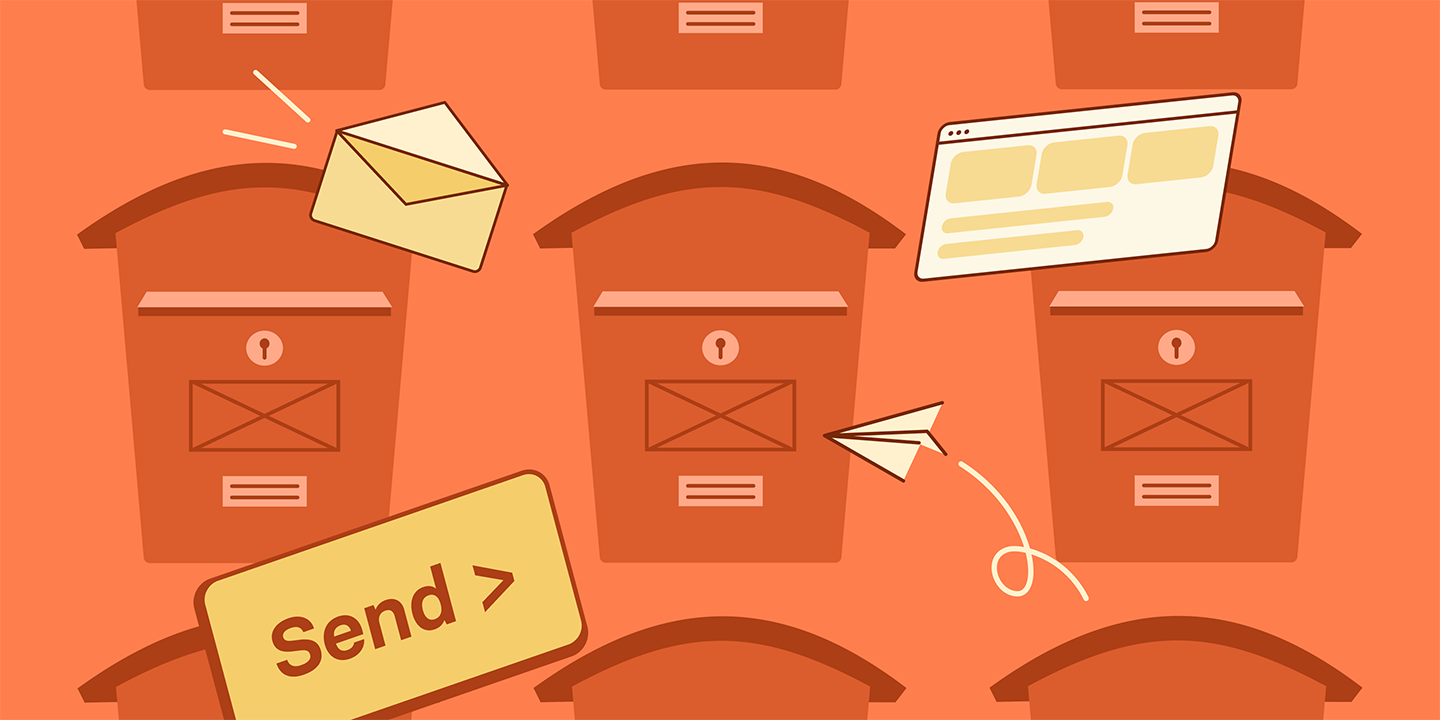Writing a great press release is only half the battle. Knowing how to send a press release correctly is key to succeeding in public relations.
Getting your press release published by news outlets is just as difficult, if not more so. Knowing how to pitch to journalists and influencers (which means sending a press release via email) correctly is crucial to getting your news release spread by the media.
Here is how to email a press release to journalists and increase your chances of getting your press release published.
Table of contents
- Before you send your press release
- How to send a press release email
- Press release email examples
- Extra tips for emailing press releases
- Final thoughts
Sign up for Prowly's 7-day free trial and send your press release for free! Create a press release, find relevant journalists, and send your emails—all in one tool.
Before you send your press release
Although we'll focus on sending a press release in this post, there's no use in emailing a press release if it's not written correctly— and more importantly—newsworthy.
Ensure your press release is written correctly
There is a standard expected format for press releases.
Why is this important?
By following a standard press release format, you’re ensuring that a journalist knows how to find what they’re looking for in your release, and allows them to quickly determine if they want to cover your announcement. It also shows them that you’re a seasoned PR pro who knows the ins and outs of a press release, and signals that you’re likely easy to work with. – Cassie Scher, Nahigian Strategies
Here’s what to include in your press release:
- Headline
- Subheader / Lead
- Dateline
- Body
- Quote
- Company info
- Logo
- Media contact information
And finally, make sure your press release doesn't contain any grammatical errors or spelling mistakes. A tool like Grammarly (or even your computer's spell checker) can help you spot any slip-ups.
💡 Get more writing tips and examples in our post: How to Write a Press Release (With Tips From PR Pros).
Ensure your press release is newsworthy
Make sure your announcement is actually newsworthy in the eyes of journalists and the public.
This means that whatever you’re sharing is relevant and/or useful to the interests of a segment of the audience of a particular media outlet.
It’s something they need to know if they follow your brand, industry, or field. It’s something that actually matters outside the organization you’re pitching for.
Ryan Morrison at Daily Mail Online once said:
I don’t think I’ve ever run a story on a company winning an award, a new contract, or the promotion or appointment of a new executive.
Ask yourself these two questions:
- Is my news something the public will care about?
- Is it presented in a way that will get people interested?
If it’s not, it might be worth waiting until you have something that actually is newsworthy or you risk making a bad first impression with the media contacts you submit your press release to.
How to send a press release email
After you've made sure your announcement is newsworthy and everything is correct, here are the 7 steps on how to send a press release by email.
1. Identify the right journalists
When you're emailing your press release, it's crucial to identify the journalists who would be interested in covering your story.
Ask yourself these two questions:
- Which journalists would be interested in your press release?
- Which publications does your target audience follow?
This should give you a better idea of the reporters and outlets you should have in mind.
In other words, there should be a fit between what you’re pitching and what the journalists you’re reaching out to usually catch.
These are precisely the people who are ready to read and respond to exactly the kind of news you’re sharing. After all, this is what they write about.
How to do it:
- If you're sharing industry-specific news, look for journalists that covered similar topics in the past.
- If you're sharing local news, additionally look for journalists that focus on a particular location.
The easiest way is by using a media database, such as Prowly.
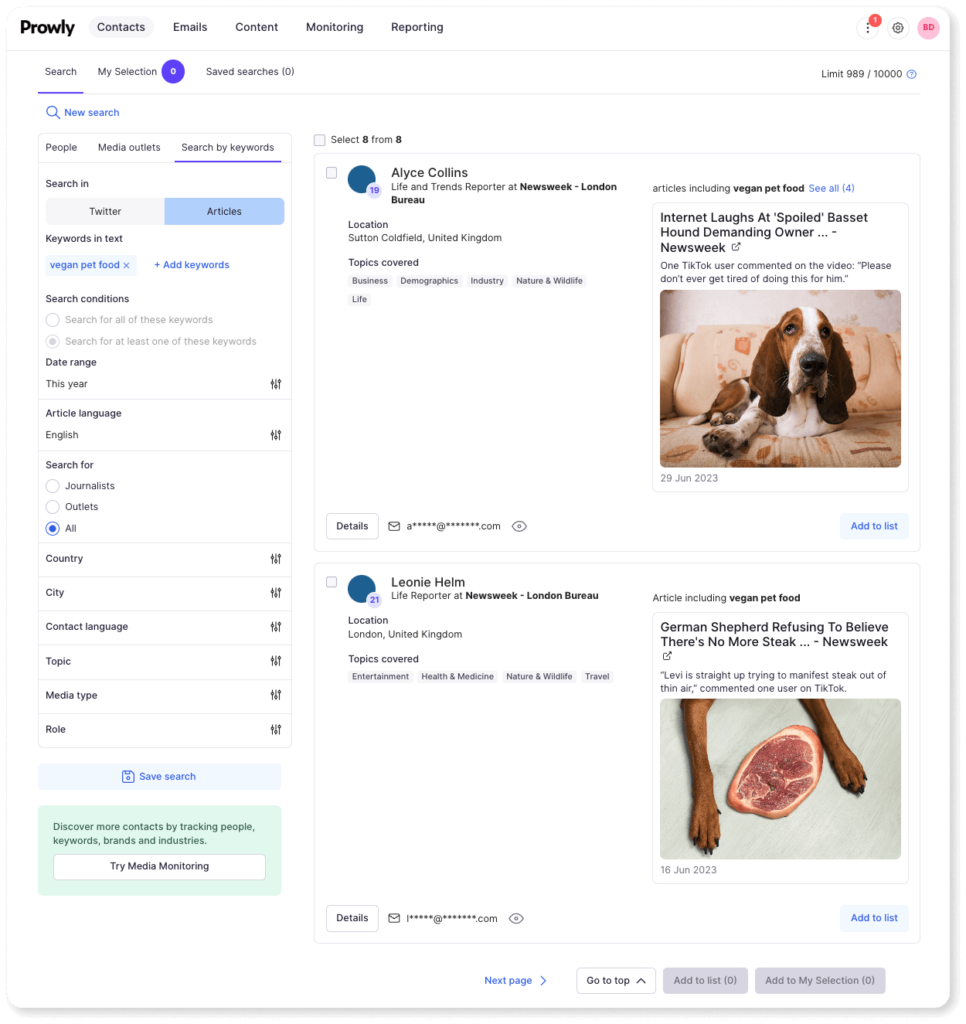
Navigate to the media database, and select "Search by keywords".
Enter keywords related to your news. This can be your industry, a particular topic, or even the names of your competitors. The more specific, the better.
For our example, let's pretend we're a pet food company releasing a new product line of vegan pet food. Let's use "vegan pet food" as a keyword.
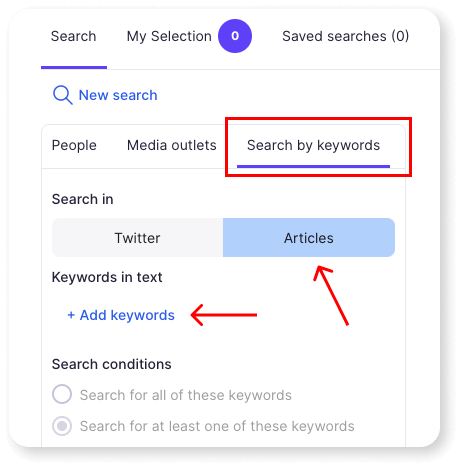
Additionally, you can narrow down your search by a variety of filters such as:
- Date range: Find journalists who recently covered a specific topic
- Location: If your news is local or country-specific
- Topic: To further narrow down your search

After you've entered your keywords and filters, you'll obtain a list of journalists and their recent articles matching your search.
From here, you can expand your research by checking what they've recently written about and the topics they normally cover.
Prowly provides their contact details and social media handles, making it easy to learn more or move on to the next step and send them your press release from the tool.
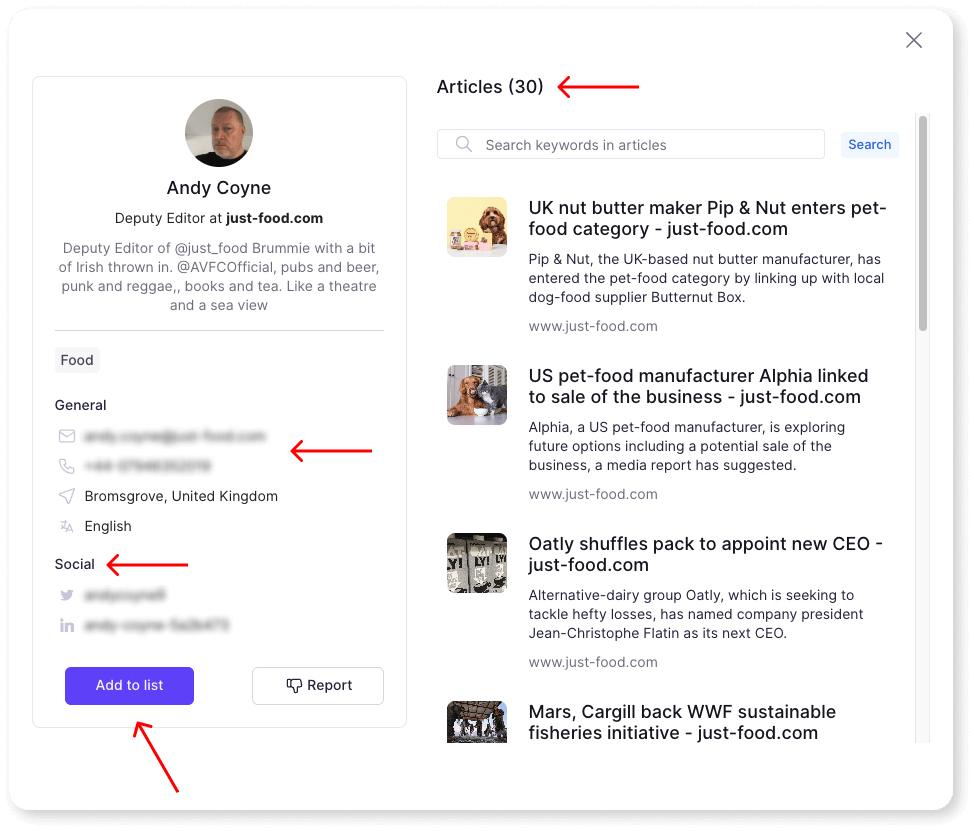
Prowly enhances contact searches with unique features:
👉🏼 Partnership with Semrush provides exclusive data on audience and traffic.
👉🏼 AI keyword suggestions expand search possibilities, opening new coverage opportunities and targeting niche topics.
To take your research to a whole new level, go to keyword search tab - with AI suggesting you can discover new, relevant keywords that might also be interesting for journalists.
💡 The new way:
- Go to the “Keyword search” tab and follow AI suggestions start with your main keyword (product category): “smartwatch” and then follow AI suggestions for related keywords and choose those that fit to your story angle (fitness or health) or be inspired with keyword ideas to give a twist to your pitch
- Narrow down your search - check articles or tweets, or both; only from last week or last month, only from online media outlets from the USA or only those posted on blogs;
- You can also see the publishing frequency - how many times a particular journalist published an article containing your keyword.
It’s like having a brainstorming buddy, coming up with pitching angles and journalists who might be interested in this topic.
Result? A short list of contacts to journalists to have been recently writing about a very particular topic, with easily accessible recent articles in the results to quickly scan them.
Make it easier to find journalists and build relationships with highly targeted contacts — learn everything about using Audience Analytics and AI Keyword research from this article.
2. Find your angle
Once you have a list of journalists that could be interested in your press release, the next step is to figure out your angle.
Journalists receive a ton of pitches and press releases every day, and having the right angle is crucial to help them quickly understand why they should cover this story.
Using an angle is important because it can change the conversation with journalists. Instead of “Do you want to cover this story?”, you can turn it into “Here’s how you can present the story”.
What is an angle in pitching journalists?
The angle is turning the facts of your press release into a story. It's essentially framing it in a way to help journalists visualize why their readers will be interested.
What's important to remember:
The angle of your press release email may depend on the journalist and publication you're sending it to. What might work for one person, may not necessarily be effective for another. While this can be time-consuming, it greatly increases the chances of your press release being picked up.
After all, when you put all the pieces together for them in a convincing way, there is no other direction to go:
✅ It’s newsworthy
✅ You’re talking to the right person
✅ The journalist can easily see why this will be interesting to the audience
💡 Option 2: Let AI craft a complete email draft for you
AI can go beyond making a summary of your press release to use in your email.
From now on, you will receive a well-structured email draft for:
- Providing an expert comment
- Proposing an interesting interview
- Sharing survey results
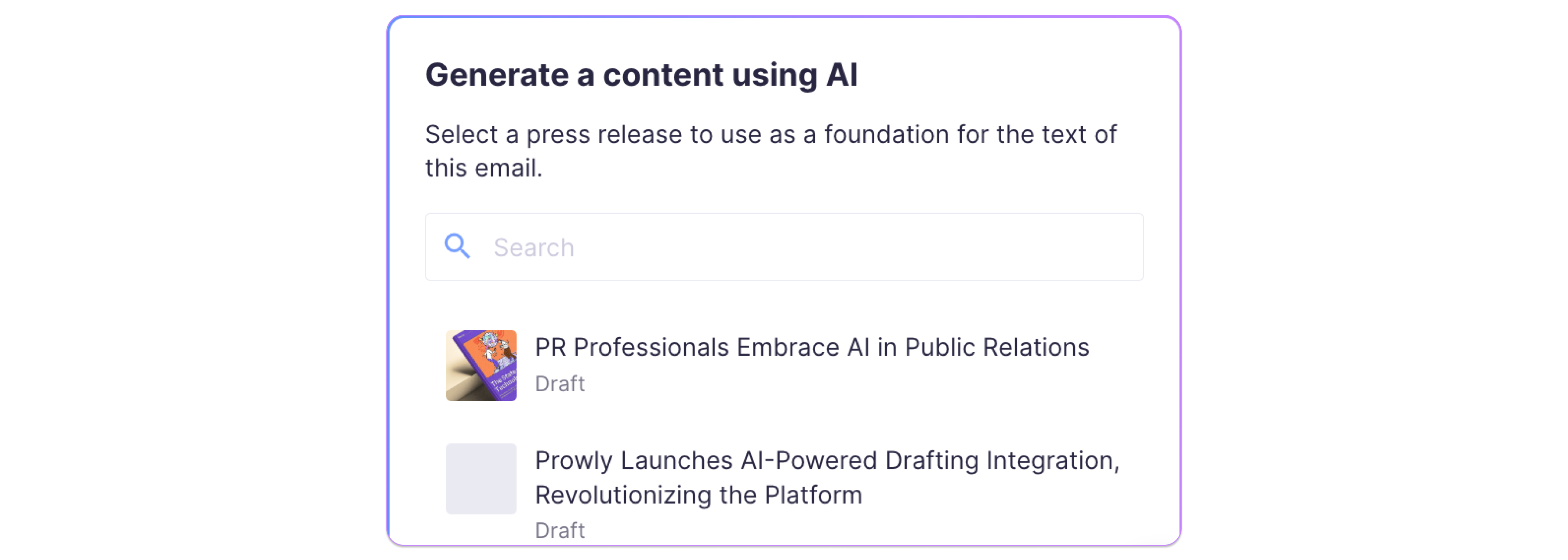
3. Write an engaging subject line
Before we move on, let’s take a moment to look at a tiny part of your pitch email that can have a huge impact on its success—your subject line. Getting it right is just as important as the message inside.
Journalists are busy people and they don't have time to read through emails that are not relevant to their interests. A direct and specific subject line that tells them exactly what your pitch is about is the best way to get their attention.
✅ Keep it short
Keep it short and to the point. Most email clients only show the first 50-60 characters of the subject line, so you need to make sure your most important information is front and center.
✅ Be direct
People often think they have to come up with witty, tabloid-style headlines to stand out in a crowded inbox to make their PR pitch subject stand out. In fact, editors and journalists will tell you this is just what not to do.
✅ Beware of spam filters
Avoid using all caps, exclamation points, or other forms of punctuation that can be seen as spammy. This can also trigger spam filters and hurt your chances in the future.
✅ Make a reference to what's inside the email
Phrases like “Story idea”, “Background on X” or some reference to a trend or ongoing story that a journalist is covering is a way to signal that you are writing for a specific reason and a clue about what they will find in your pitch.
✅ Mention multimedia or interactive elements
Examples & Tips
PR Manager, Corina Leslie at ZeroBounce shares her two strategies for starting engagement:
Tip #1: Start your subject line with the word “pitch” so the writer knows right away what to expect.
- Example #1: Pitch: + your context and story in a few words
- Example #2: Pitch: + the actual headline of your story
Tip #2: Personalize it by using the person’s name.
- Example #1: I wrote this article for you, (Name)
- Example #2: (Name), here are 3 ways to (solve industry problem)
👉🏼 Read more: Media Pitch Subject Lines – Best Practices & Examples
💡 Option 2: Let AI suggest you a few topics
You can either wait for a great topic to come to you, or you can break through writer's block with AI. Prowly's AI Assistant can suggest a few topics, which you can then refine and adjust until you achieve the best possible result.
4. Write your press release email
Now it’s time to write the message you’re going to send to the journalists you've selected.
This is where you ask them to get interested in the announcement you’re sharing using your angle— interested enough to cover it in their own words in their media outlet.
And just as the emphasis in the previous step was creating a focused, relevant list of contacts, the theme in this step is to create a focused message containing only relevant information.
Greeting
The greeting is a small, but important part of the email. Keep these things in mind:
- If you haven't interacted before, stick with a general greeting, such as "Hi", "Hello" or "Dear".
- Be sure to mention their name. Double-check that you've spelled it correctly.
- If you've been in contact before, you can use a more personal greeting, and make a reference to the past.
Introduction
Before you get to pitching your press release, make a personalized introduction. This will help you make a connection with the journalist, and show that you've done your research and you're not sending a mass email.
This is the part of your email where you should mention why you're reaching out specifically to them. You can make a reference to previous articles they've written, especially if they are related to the news you want to share.
Keep this part of the email limited to 1 sentence. Remember that journalists get tons of emails just like yours every day and they’re not going to spend their time following you as you slowly get to your point.
Email body
The email body is the meat of your message. This is where you present your angle and the most important parts of your news. Now that you've previously gotten the attention of your recipient, the next step is to get them excited with your news.
- Include the most important takeaway from your press release in the first sentence. Mention an intriguing statistic or share a key statement that aligns with your angle.
- Once you have their attention, share more information about your news. Include the 5Ws – what, where, who, why, and when. This is where you can mention that you've included your press release below, where the journalist can read more if they are interested.
- Offer exclusivity and additional value by offering something extra, such as an interview with a key person at your company, additional information, or assets.
💡 Option 2: Refine your draft with AI and add a human touch
Every draft generated by AI requires improvements and editing. The inline editor makes this process smooth and quick. Users can select any part of the text—whether it's a sentence or a paragraph—that they feel needs polishing and ask the AI to rewrite it.
5. Include your press release in the email
Once you've written your email, you have to include your press release somehow. After all, this is why you're emailing journalists.
Journalists have a preferred preference for how they receive press releases:
- Paste your press release below your email signature or additionally add a link in the body of the email
- Avoid including your press release or more than 2-3 images as attachments – they can trigger spam filters
- If you want to include more assets, share a link or mention that you provide them on request


6. Send your email
To improve the chances of your press release getting published, make sure the journalists actually read it.
Don't ask them to click on a link and go to another page – keep it simple. If you’re using a PR outreach tool like Prowly, the process is a lot easier.
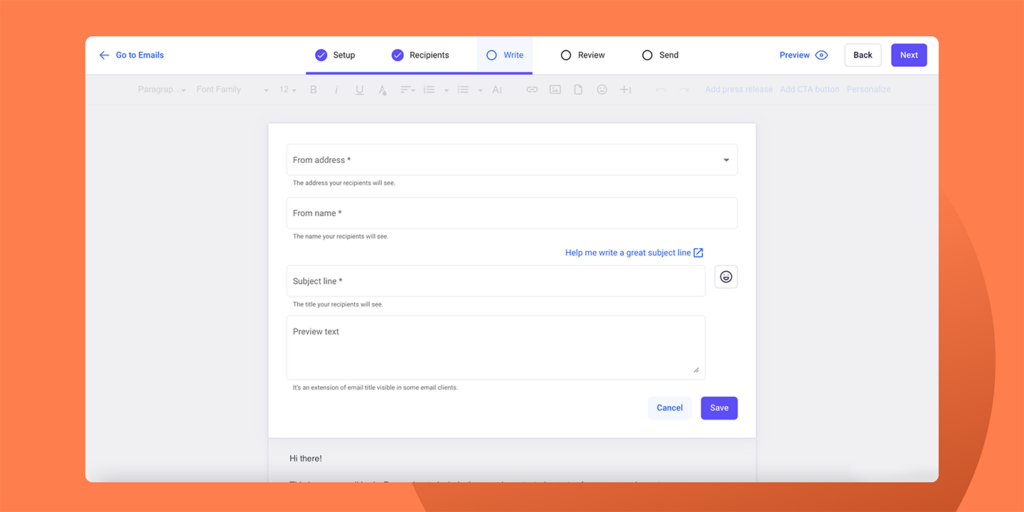
Prowly offers 1:1 email personalization as part of its pitching flow. This means you can easily keep all your personalized send-outs within the app, saving you time and gaining the extra benefit of automated data analysis.
You have the freedom to personalize not just the greeting but also the content of the email pitch and attachments. Start by creating a default version and then make adjustments as needed.
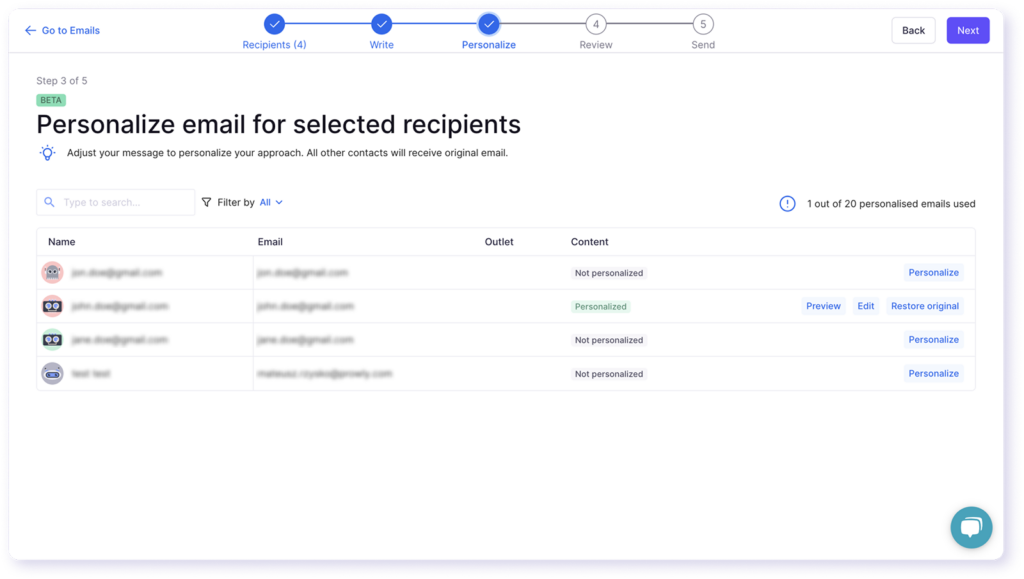
💡If you're seeking more exposure for your press release, explore these 10 ideas on how to effectively promote a press release.
7. Follow up if needed
One of the less pleasant parts of pitching to journalists is the follow-up.
A few days have passed and the journalist’s response is nowhere to be found. You can almost hear the crickets chirping. Did they read my press release? Did they open my email? Did they even get my email?
While it’s possible that the journalist has simply no intention of covering your story, it’s important to remember that journalists are, simply put, busy.
A safe way to follow up is to wait a few days and send them another email and provide additional information.
If you're using a PR outreach tool, like Prowly you're able to view individual email statistics for each journalist you send your press release to, including:
- open rates (who opened your email)
- click rates (who viewed your press release)
- and bounce rates (indicating when there was a problem with their inbox).

In addition to these, Prowly also allows you to track how long journalists spend viewing your emails, giving you insight into their level of engagement with your content. If you notice that a journalist briefly opened your email, you might consider re-engaging them with more targeted follow-up content.

Furthermore, Prowly’s AI-powered inline editor can assist you in refining your emails by suggesting edits and improvements to your sentences, helping you craft more compelling and polished messages.
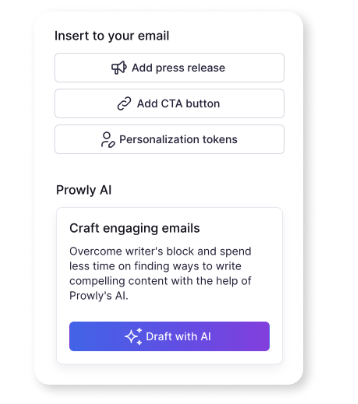
You can analyze each touchpoint a journalist has with your email using Prowly. Go to the Recipients tab and click on the media contact name you’re interested in. You’ll see exactly when and how many times they opened the email, along with what content they clicked on.

This makes the follow-up process a lot easier because you’ll know how to approach the journalist knowing if they’ve even opened your email – or even set up automated follow-ups if they haven’t.

If you are following up with journalists, avoid asking if they read your press release. Instead, make your follow-up more compelling by adding something new.
Consider including a fresh angle or interesting points that you didn't mention in the first email. This second chance allows you to grab their attention again and can get them eager to read the full press release.
And mostly importantly, follow up only once. Repeatedly following up will make you look unprofessional and hurt your future chances of connecting with that journalist.
Press release email examples
Here are two examples of press release emails that you can reuse, created in Prowly.
Example #1
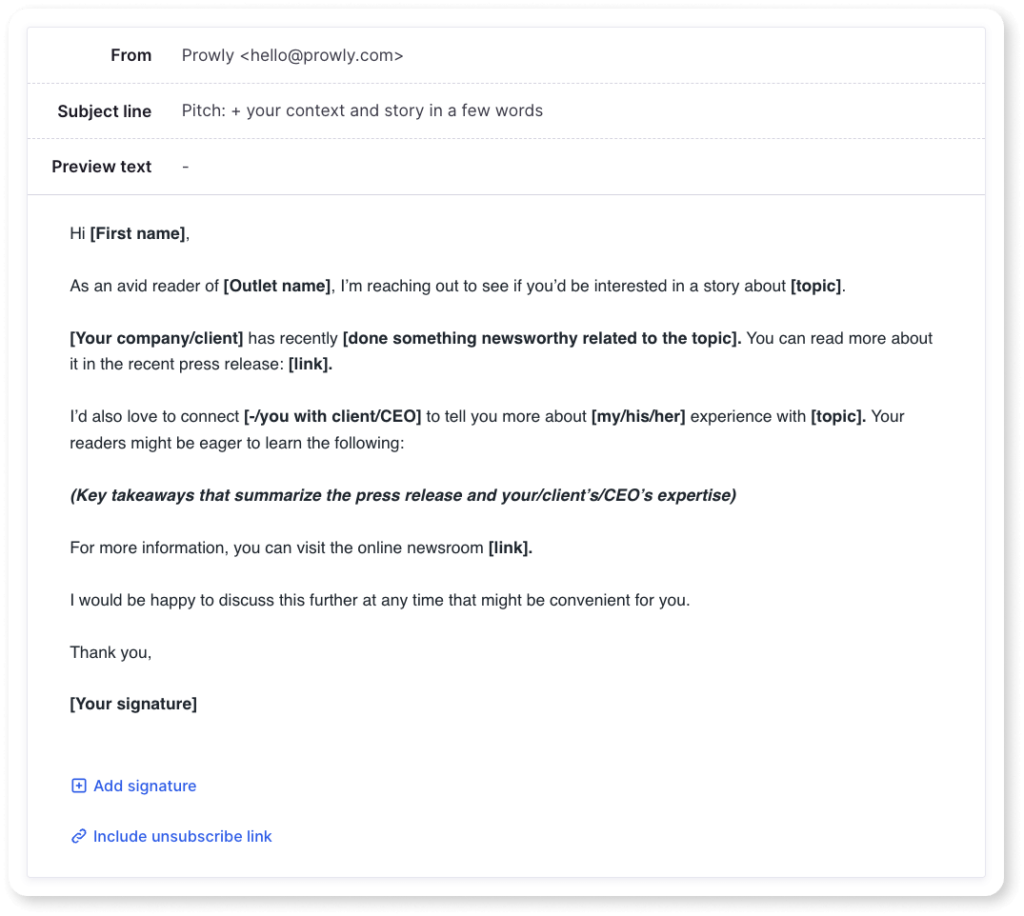
Why this is a good example:
- A clear, simple introduction
- A personalized message with the name of the journalist’s outlet mentioned
- Right to the point about the newsworthy event
- An invitation to learn more via a press release, either attached to the mail or online
- An offer to set up an interview
- Some key points that would be covered in a conversation
- Another invitation to an online newsroom
- Another invitation for a follow-up conversation
Example #2

Why this is a good example:
- A clear, simple introduction
- A reminder about a past connection
- Personalization through a reference to the journalist’s outlet
- A reference to the journalist’s recent work, with details
- A reference to a newsworthy event and an invitation to connect with the experts behind it
- Reasons why the journalist’s readers would be interested
- Other media coverage of the people involved
- An open invitation to connect and discuss it further
Sending press releases with AI
Many PR tools like Prowly now offer AI-powered features that can simplify the entire process of sending a press release.
AI can help with:
- Finding relevant media contacts
- Crafting press releases
- Generating entire press release emails
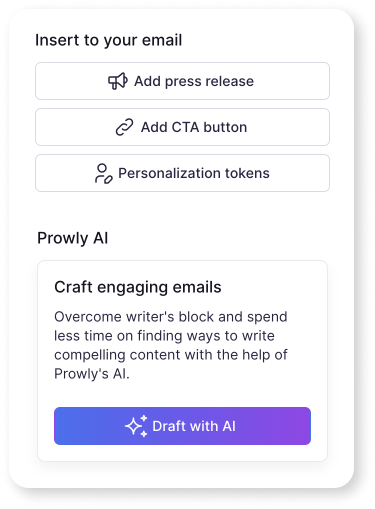
These tools can be useful for quickly generating first drafts or overcoming writer's block, but it's still crucial to know the do's and don'ts of writing a press release email to ensure your message is correct.
Extra tips for emailing press releases
Pick the right time to send out press releases
If you’re writing a press release about an event or a product launch, remember to submit your press release to the media early enough so you have time to get media coverage before your event or product launch occurs.
It’s also important when journalists receive your press release email. The best day to email a press release is on Thursday when the average open rate jumps to over 26%! The worst days are Wednesdays and Fridays when even 85% of your emails can get lost in journos’ inboxes.
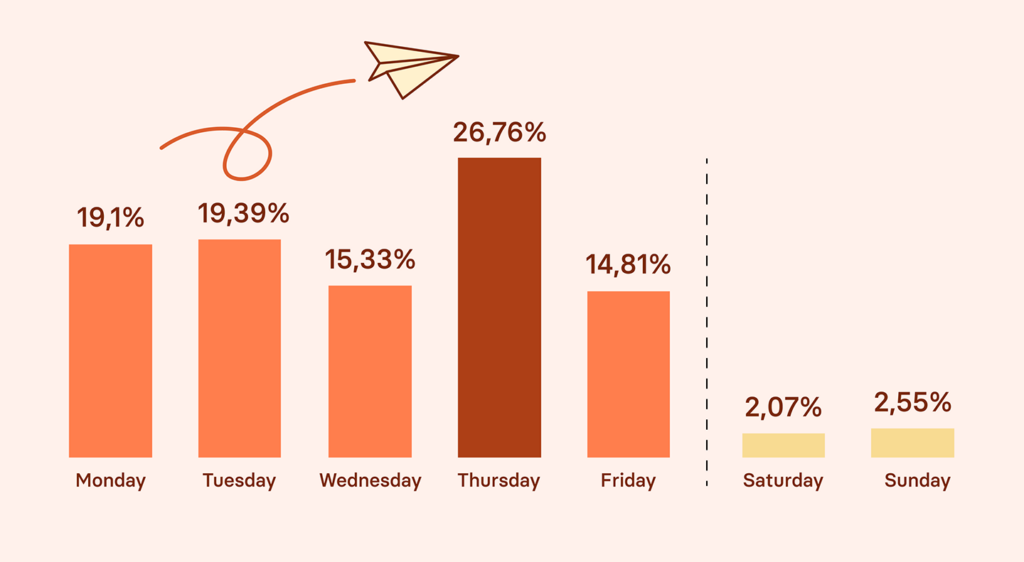
Which hours are best for sending a press release via email?
Research shows that early mornings are less effective: open rates drop to 20.5% between 6 and 10 am. If you do decide on the morning, wait at least until around 8 or 9 am.
Avoid grammatical errors and typos
Even if your press release contains everything it should, a typo—or even worse—a major grammatical mistake, can seriously damage the trustworthiness of you and your news.
Double-check your press release with a grammar-checker like Grammarly or ask someone from your team that you trust to have a second look.
Make sure local news goes to local reporters
When it comes to sending press releases to local media, it's crucial to reach out to the editorial offices of local newspapers, publishers, and journalists in your specific city or region. By crafting compelling stories and sharing them with local newspapers, publishers, and journalists, you can spark genuine interest among consumers in your region.
All mentioned guidelines apply. The magic lies in the ability to personalize your pitches and in building meaningful relationships with journalists. Also, don't overlook the potential of local radio and TV stations, they could be your ticket to getting your story heard by a broader audience.
Final thoughts
If you’ve made it all the way here, congratulations! By this point, you should have the essential knowledge on how to send a press release email to journalists.
To sum up, follow these steps:
- Ensure your press release is on point and newsworthy.
- Research which journalists or media outlets would be most interested in covering your story and find their contact information.
- Find an angle for your pitch to get journalists excited about your news.
- Craft an email that is short, simple, and compelling to encourage journalists to read your press release.
- Avoid sending large attachments or other materials that could be seen as burdensome or unnecessary.
- Time the release of your press release for maximum impact and visibility.
- Follow up with journalists after sending your press release to increase your chances of getting a response.
Ready to send a press release?
Sign up for Prowly's 7-day free trial and send your first press release for free. Send personalized emails at scale to engage journalists and move your conversation forward.
